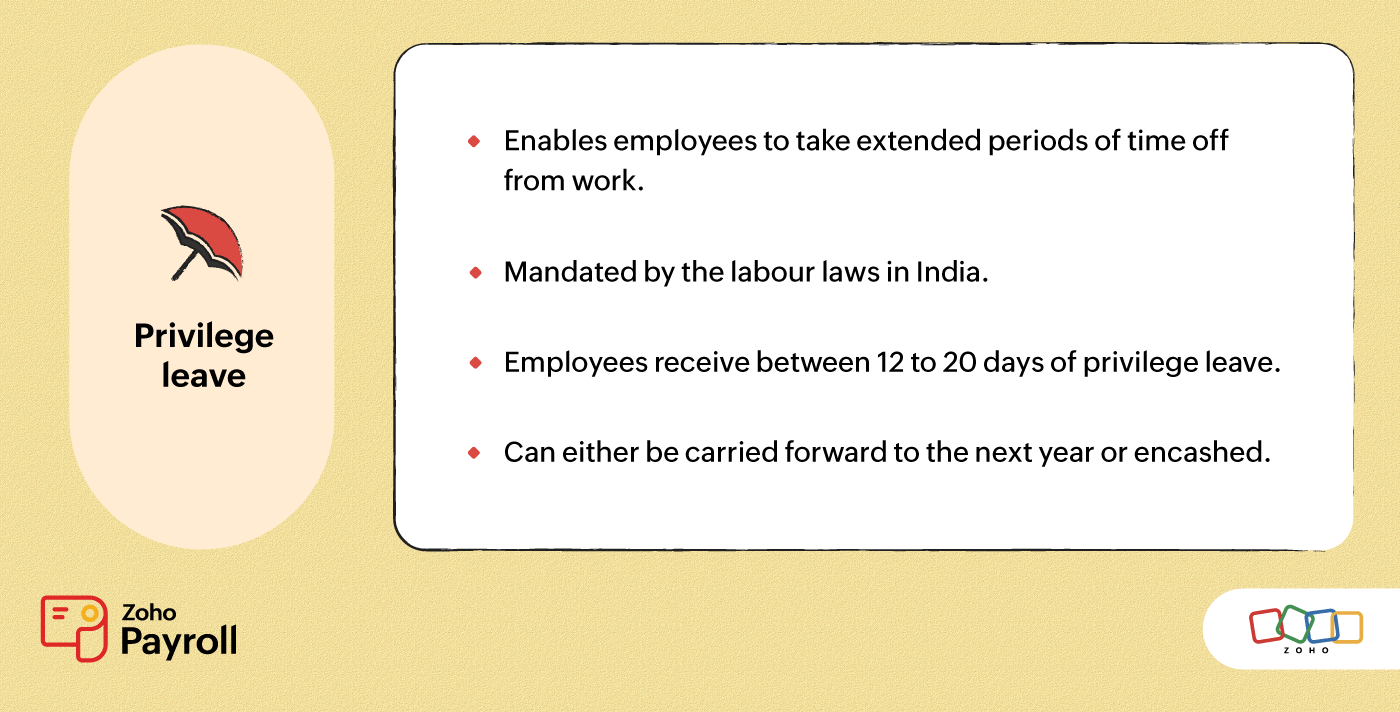- HOME
- HR and payroll
- 13 types of leave offered by companies in India
13 types of leave offered by companies in India
As India's startup and small business ecosystem continues to flourish, attracting top talent and fostering a healthy work environment becomes essential for sustainable growth. Implementing a well-designed leave policy will not only help you attract and retain top talent but also nurture a motivated and engaged workforce.
In a survey conducted by Met Life in 2022, 81% of employees stated that having paid leave drastically improved their mental health.
Moreover, providing adequate amounts of leave to your employees is essential for complying with the country's labour laws and regulations. In this guide, we will explore the different types of leave, including sick leave, casual leave, maternity leave, and more. By discussing about each leave type, the legal provisions, and best practices, we aim to equip you with the knowledge necessary to create the most effective leave policy for your organization.

13 different types of leaves
In a diverse country like India, where the labour laws are regionally distinct, the number of leaves an employee is eligible for in a year may vary from one state to another. However, the types of leave and their applicability are the same throughout. With that in mind, we will delve into the following leave types in detail:
- Sick leave
- Casual leave
- Paid leave
- Maternity leave
- Paternity leave
- Marriage leave
- Childcare leave
- Bereavement leave
- Sabbatical leave
- Compensatory leave
- Compassionate leave
- LOP leave
- National holidays
Sick leave
Sick leave is a type of paid leave that employees can take when they are sick or injured. It is intended to allow employees to recover from their illness and to return to work healthy.
Duration: The amount of sick leave that employees are entitled to varies by company. However, the government of India mandates that all employees are entitled to at least 12 days of sick leave per year.
Employees who take more than three consecutive days of sick leave, must produce a medical certificate to approve their leave requests.
Carryover rules: Unused sick leave cannot be carried forward to the next year, nor can it be encashed. This encourages employees to prioritize their health and take time off from work whenever they need it.
Learn everything about sick leave.
Casual leave
Casual leave, also known as unplanned leave, is a mandatory leave that employees can take for personal reasons. It enables employees to take time off from work for unexpected or unplanned events.
Duration: Companies often provide up to 12 casual leave requests per year and employees get their full wages during this period. The duration of casual leave may vary, ranging from a few hours to a couple of days.
Unlike other types of leave that may require prior approval, casual leave is typically granted on short notice and provides employees with the freedom to handle personal matters.
Carryover rules: Generally, companies do not allow employees to carry forward or encash unused casual leave.
Learn in-detail about casual leave.
Privilege leave
Privilege leave, also known as earned leave or paid leave, is a type of mandatory leave provided to employees as a privilege for their continuous service to the company. Employees earn this after a specific number of working days. This type of leave enables employees to take extended periods of time off, such as for vacations or family events.
Duration: The calculation of privilege leave is typically done on a pro-rata basis. Eligible employees generally receive between 12 to 20 days of earned leave per year.
Paid leaves are pre-planned and need prior approval from the employer.
Carryover rules: Most organizations provide employees the option to carry over or encash their unused paid leave. Companies allowing leave encashment may credit the equivalent amount at the start of the following year or upon employee resignation or retirement. Read more about the calculation and taxation of encashed leave in our guide on leave encashment.

Maternity leave
This is a paid leave provided to employees who are pregnant, ensuring they have time to recover and bond with their newborn child.
Applicability: As per the Maternity Benefit Act of 1961, female employees pregnant with their first two children are eligible for maternity leave for up to 26 weeks. Out of these 26 weeks, up to 8 weeks can be taken before the expected delivery date. In the case of a third child, the maternity leave duration is limited to 12 weeks.
Entitlements: During the maternity leave period, employees are entitled to receive their full wages, equivalent to their last drawn pay. Additionally, the Maternity Benefit Act extends leave benefits for cases of miscarriage, surrogacy, or adoption.
Learn in-detail about maternity leave.
Paternity leave
Paternity leave is a paid leave granted to male employees following the birth or adoption of a child. It allows them to actively participate in the care and upbringing of the child.
Applicability: Unlike maternity leave, paternity leave is not yet mandatory in India. The Paternity Benefit Bill introduced in 2017, says eligible fathers can avail a paternity leave of up to 15 days. Once the bill is enacted, it will become mandatory for all organizations to provide fully paid paternity leave to their employees.
Marriage leave
Also known as wedding leave, marriage leave is a leave granted to employees who are getting married. It allows employees to go on leave, prepare for their wedding, and to celebrate their marriage.
Applicability: This leave is not mandated by the country's labour laws, and its applicability and duration vary depending on the policies of each company.
Duration: Typically, employees who are legally getting married for the first time are eligible for marriage leave, which can last up to 15 days. During this period, employees will receive full wages equivalent to their last drawn pay.
Certain companies may require employees to provide supporting documentation such as a wedding invitation or marriage certificate to validate their eligibility for marriage leave.
Childcare leave
This leave is typically granted to female employees with children below the age of 18 to attend to the child's needs, such as sickness or examinations.
Entitlement: It is offered as a benefit to employees working for the central government or the railways department. Eligible employees can avail up to 730 days of leave during their entire service to care for their first two children.
Bereavement leave
In the unfortunate event of the loss of a family member or loved one, employees are granted bereavement leave, which provides them with the opportunity to grieve and make necessary funeral arrangements.
Applicability: While the concept of bereavement leave is relatively new in India, it is not mandated by the country's regulations. However, many companies have chosen to offer this leave to their employees on the grounds of compassion.
Duration: The length of bereavement leave an employee can avail varies among companies. Some provide a set number of days, while others offer flexibility based on individual circumstances.
Sabbatical leave
Sabbatical leave is a type of extended break given to employees, allowing them to enhance their skills, pursue personal interests, or simply take a well-deserved break. The duration of such leave can range from a few weeks to several months, or even a year.
Typically, sabbatical leave is granted to employees who have completed a certain number of years of service or have achieved specific career milestones.
Applicability: While offering such leave is not mandated by the country's laws, many companies are gradually including sabbatical leave in their policies to provide flexibility to their employees.
Duration: The terms and conditions of sabbatical leave can vary between companies. Some may offer partial or full pay during the leave period, while others may provide unpaid leave.
Compensatory leave
Also known as comp-off, compensatory leave is paid time off that employees receive in exchange for overtime hours worked. This means if an employee works an extra day or hour, they are entitled to a day or hour of compensatory leave.
Unlike other types of leave that expire at the end of the leave year, comp-offs have a specific expiry period of a few weeks, within which employees must utilize them.
Benefits: It allows employees to be compensated for their overtime work without having to be paid overtime wages. This can be beneficial for both the employer and the employee, as it can help to reduce the employer's overtime costs and can give the employee more flexibility in their work schedule.
Applicability: Compensatory leave is not mandated by law, but it has become a common practice in many organizations.
Compassionate leave
Compassionate leave is paid leave granted to employees to take care of a seriously ill or injured family member.
Benefit: Compassionate leave allows employees to focus on their family, or cope with the stress of an illness without having to worry about their job.
Applicability: While compassionate leave is not a legal requirement, many companies offer it as a way to support employees. The length of compassionate leave varies, but it is typically between 2 and 10 days.
LOP leave
LOP leave, also known as loss of pay leave, employees take when they do not have enough leave balance to cover their absence. This means that employees who take LOP leave will not be paid for the days they are absent.
The benefit of LOP leave is that it allows employees to take time off when they need it, even if they do not have enough leave balance.
Duration: Most organizations provide this option to offer flexibility to their employees, but the number of such leaves that an employee can avail in a year is limited to five days.
National holidays
This refers to time off granted to employees on designated public holidays. These holidays include Independence Day, Republic Day, Gandhi Jayanti, and various religious festivals celebrated nationwide, like Diwali and Eid.
Entitlement: Employees can take the day off on national holidays with pay, allowing them to celebrate, observe, or spend time with their family and loved ones.
Applicability: These holidays are typically determined by the government and may vary from state to state. It is important for employers to adhere to the national holiday calendar and ensure employees receive their rightful leave entitlement on these days.
Now that we have covered the common types of employee leave in India, the next step for you is to create the most effective leave policy for your organization.
Designing an effective leave policy
Crafting a comprehensive leave policy requires consideration of legal requirements, company culture, and employee needs. It is crucial to establish clear guidelines for leave accrual, utilization, requests, and approval processes.
An integrated HR and payroll software can greatly simplify leave management for you. This software enables employers to create leave policies that adhere to labour laws while enhancing the employee experience. HRMS automates tasks such as tracking leave balances, carrying forward or encashing applicable leaves, and facilitating digital leave applications and seamless communication between employees and HR.
In conclusion, it is crucial for employers to understand the various types of leaves applicable for employees in India. By creating well-structured leave policies with the help of modern HRMS software, organizations can efficiently manage leaves, promote employee wellbeing, and ensure compliance with labour laws. Ultimately, this fosters a positive work environment.




